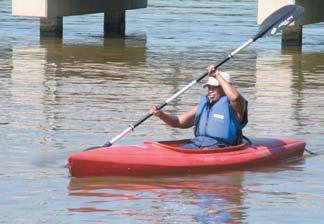
3 minute read
The Bridge, Ancient Wisdom and Environmental Protection
from Waterkeeper International
by ⌘ ⇧ ⌥
The Bridge
ancient Wisdom and environment Protection
Mati Waiya is Ventura Coastkeeper
By angela mooney D’arcy
»tHe relationsHiP of Tribal people to their land and water has existed since time immemorial. Tribal systems of governance, ecological management, community and cultural practices were in place since long before the founding of the United States, and long before what we now call the environmental movement. Indigenous communities are the Elders of this earth and possess critical ecological knowledge that should always be incorporated in environmental stewardship plans and practices.
Wishtoyo Foundation and Ventura Coastkeeper are building bridges between environmental protection and cultural survival, demonstrating that each is stronger with the other. Wishtoyo is the Chumash word for rainbow, and like the legend telling of the arrival of the first Chumash settlers on a rainbow bridge from Santa Cruz Island, Wishtoyo serves as a bridge to link the people of today to their environment — the land, air and water that support and sustain us.
Founded in 1997 by Mati Waiya, Chumash member of the Santa Clara River Valley Turtle Clan, Wishtoyo utilizes traditional Chumash beliefs, practices, songs, stories and dances to create greater awareness of our connection with, and dependence upon, the natural environment. Wishtoyo’s mission is to protect and preserve the culture and history of coastal communities and foster responsibility to our waters through education, research and community action. Wishtoyo launched Ventura Coastkeeper in November 2000 to spearhead citizen enforcement and watershed protection.
In 2003, Wishtoyo and Ventura Coastkeeper released, “Agritoxins: Ventura County’s Toxic Time Bomb,” a study on the health effects of agricultural pesticide use in Ventura County. Ventura Coastkeeper implements the recommendations of the report to protect nearby communities, farm workers and children from these dangerous chemicals. For example, in spring 2006, a lawsuit brought by Wishtoyo Foundation and Ventura Coastkeeper, in coalition with community-based environmental justice groups, forced California to reduce smogforming emissions from pesticides. Ventura Coastkeeper is also fighting to uphold restrictions on the use of methyl bromide, a highly toxic strawberry field fumigant, a poison, that should be kept away from farm workers and their children, off our food and out of our streams. W

Ventura Coastkeeper’s Stream Team is a citizen monitoring program for the Calleguas Creek watershed, which supplies more than a quarter of the county’s needs for drinking and irrigation water. Volunteers test water for agricultural runoff, sewage, sediments and other pollutants.
Wishtoyo Foundation’s Chumash village Project is a living Native American village on a four-acre site at Nicholas Canyon County Beach in Malibu.

Chumash inhabitance extended along the southern California coast and the Channel Islands for over 10,000 years. Theirs was a maritime culture, dependant on the sea for trade, travel and food. The Chumash were excellent fisherman, utilizing fishing nets, lines and hooks as well as harpoons and spears. Chumash diet consisted of over 150 types of marine fishes and varieties of shellfish. Their tomols (plank canoes) were sturdy and capable of travel between the Channel Islands and the shore, establishing their coastal villages as trading centers between inland peoples, coastal villages and island dwellers. The restoration at adjacent Nicholas Canyon Creek completes the historical vision of a natural habitat that sustained the Chumash for thousands of years; marine, freshwater and plant resources have been restored to their historical beauty.
L AMONEA RANK F The site includes aps, authentic Chumash dwellings, made in the ancient manner from tule or bulrush and willow branches.
Wishtoyo hosts solstice ceremonies, blessings, celebrations and educational presentations, offering a multisensory experience of daily life as it existed for thousands of years. Here, a solstice stick stands in front of one of the site’s aps.








